In mid-September, Iran’s pandemic began a third wave, with more than 3,000 new COVID-19 cases a day. Deputy Health Minister Iraj Harirchi declared a COVID-19 red alert for the entire country on September 18. The government ordered the closure of schools, universities and mosques in Tehran and Zanjan. The partial lockdown was expanded to 41 other cities in late October. “If the current course continues, the death toll will reach 45,000,” Harirchi warned on television. On November 27, Iran recorded a daily high of 14,051 new cases. The spike in cases exceeded the two earlier peaks in March and June. More than 31,000 nurses were infected and 54 had died from the coronavirus, according to the national nurses' organization.
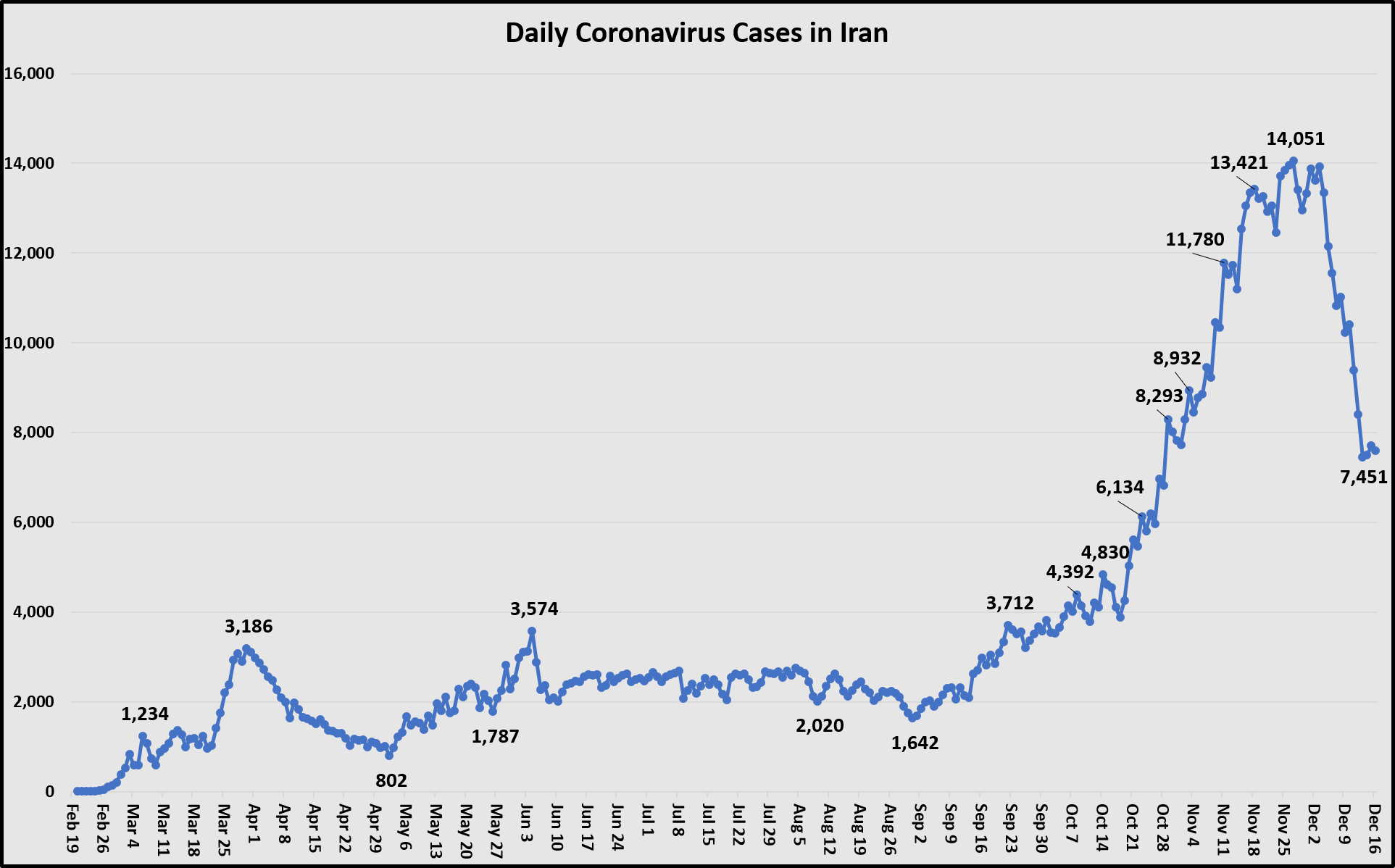
On October 11, two senior government officials contracted COVID-19: Ali Akbar Salehi, head of Iran's atomic energy agency, and Mohammad Bagher Nobakht, vice president of budget and planning. On October 28, Majles Speaker Mohammad Baqer Qalibaf tested positive. Since the outbreak first reported on February 19, dozens of officials have been infected or died.
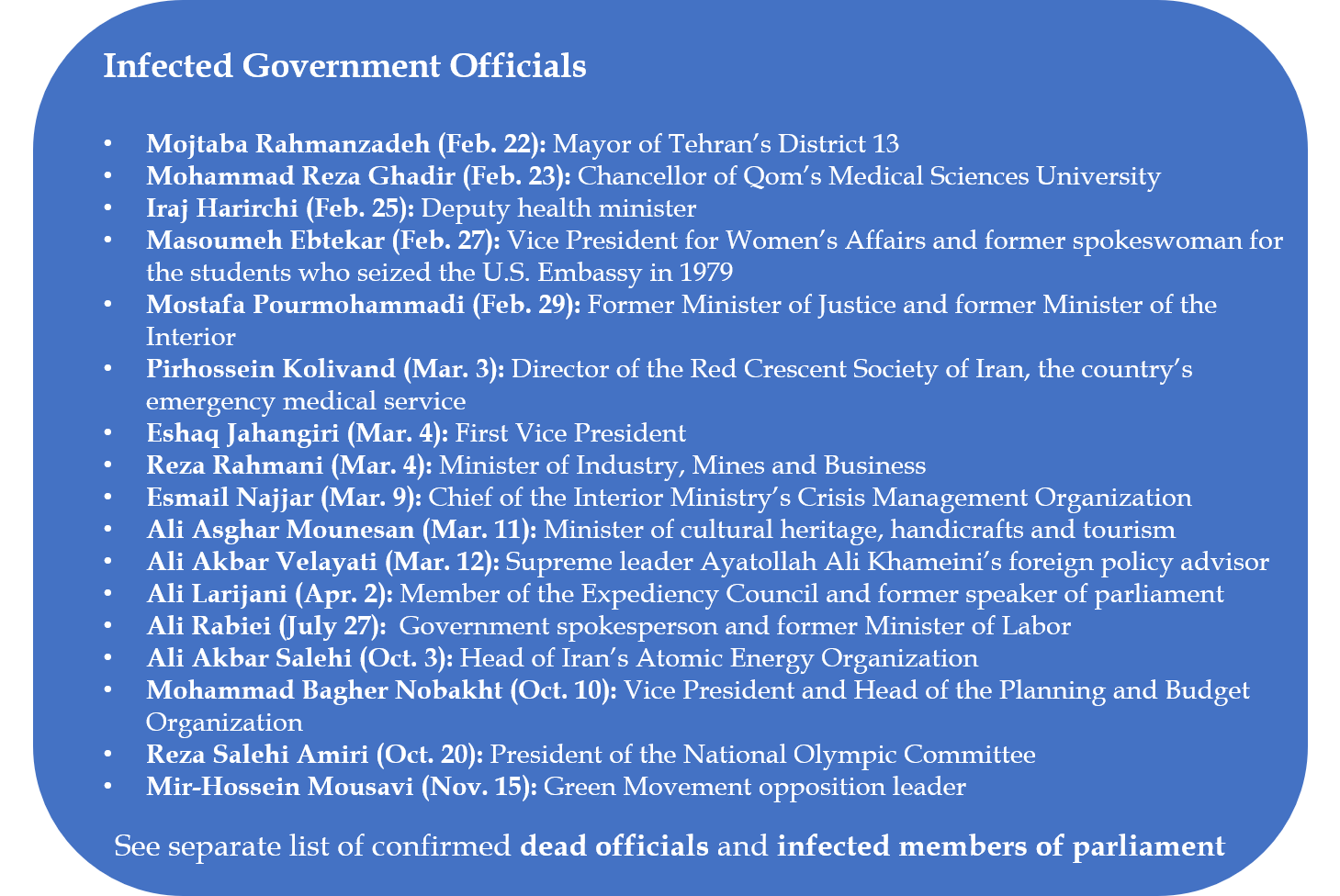
The government threatened strict punishments against Iranians who ignored public health protocols. “Those who hide their disease should be fined," President Hassan Rouhani warned on October 3. Punishments for not wearing a mask included a 500,000 rial fine ($1.55), year-long suspensions from jobs and closure of businesses. Iran, an early epicenter of the deadly virus, reported a total of 1,123,474 cases and 52,670 fatalities between Feb 19 and December 16, 2020—a mortality rate of 4.7 percent. (The global mortality rate at the time was 2.2 percent; the U.S. mortality rate was 1.7 percent). But the actual death toll8might be three or four times the official tally, according to a senior member of Iran's medical professionals organization.
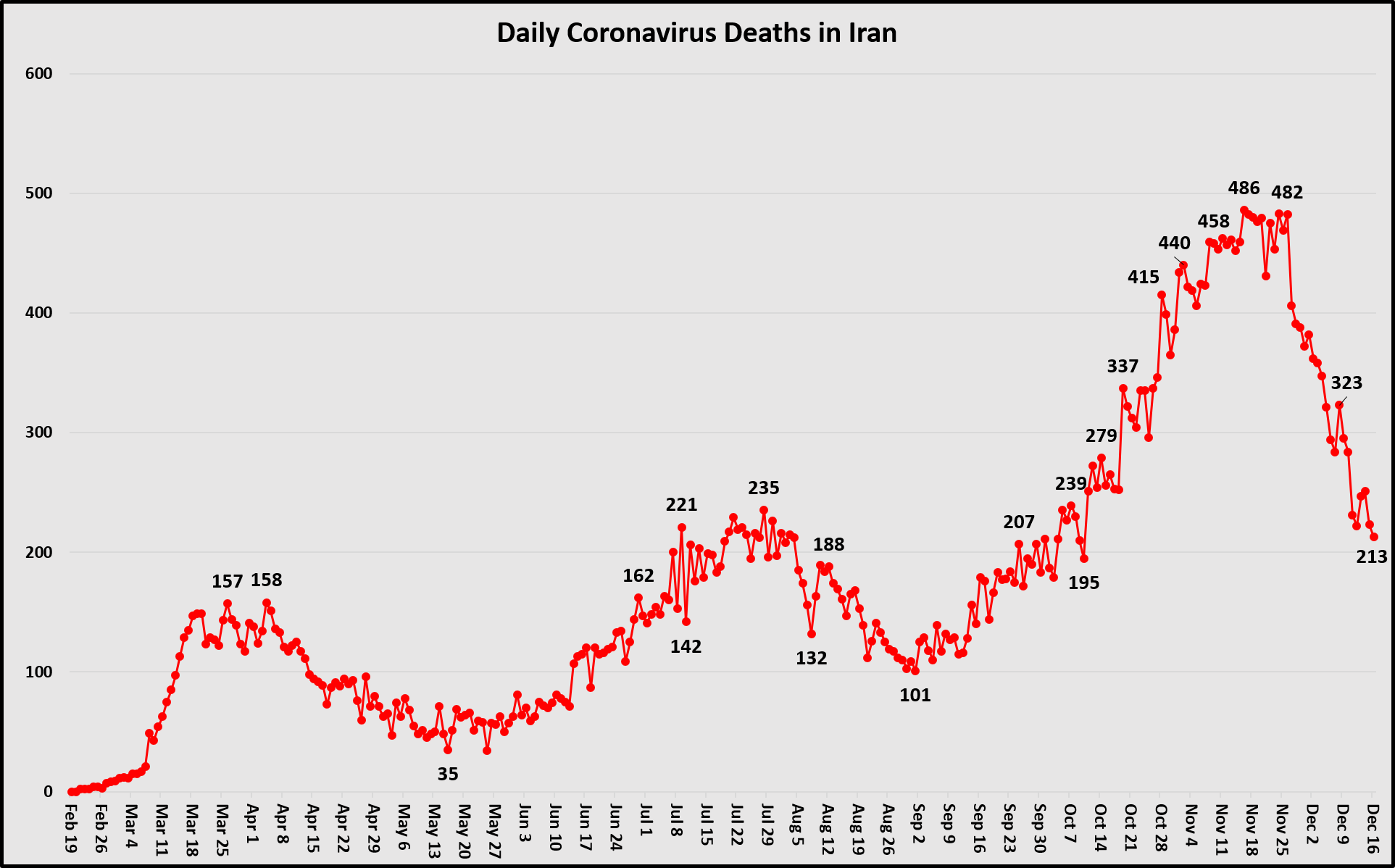
As of December, 27 out of 31 provinces, were considered "red zones" due to the high number of infections. They included: Alborz, Ardabil, Bushehr, Chaharmahal and Bakhtiari, East Azerbaijan, Gilan, Hamadan, Ilam, Isfahan, Kerman, Kurdistan, Kermanshah, Khorasan Razavi, Khuzestan, Kohgiluyeh and Boyer-Ahman, Lorestan, Markazi, Mazandaran, North Khorasan, Qazvin, Qom, Semnan, South Khorasan, Tehran, West Azerbaijan, Yazd and Zanjan.
Three others provinces—Golestan, Hormozgan and Fars—were considered “orange” zones because they had the second highest infection rates. Sistan and Baluchestan province was considered in the "yellow" zone for having the third highest infection rate.
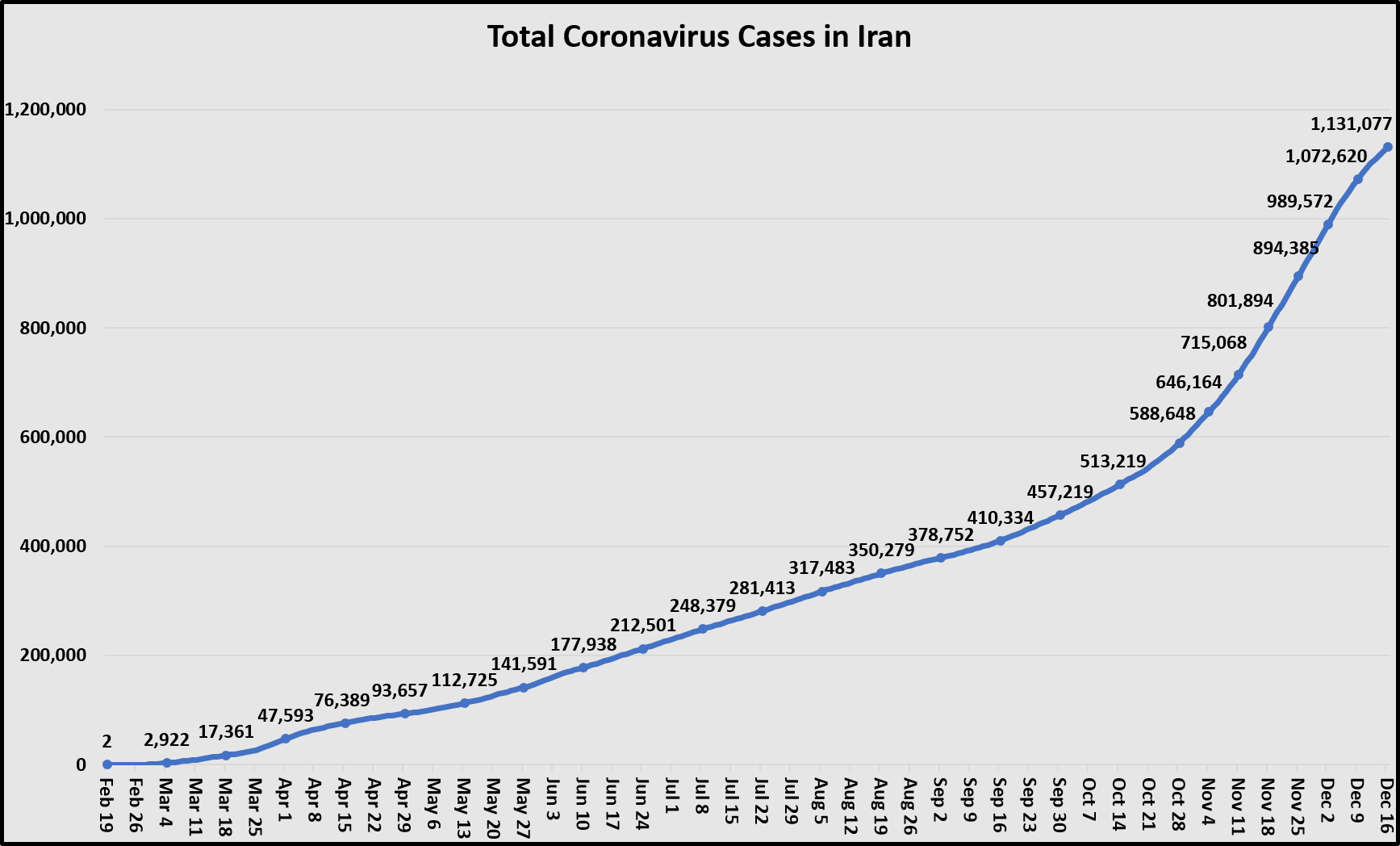
Iran shut itself down in stages. On September 26, provincial governors were given discretionary power to impose one-week lockdowns of schools, universities, mosques, cafeterias and other public places, depending on the severity and number of cases. Nationwide, the government canceled celebrations for the Shiite holiday of Arbaeen commemorating the death of Imam Hussein on October 7-8. The government instructed pilgrims not to travel to Iraqi holy city of Karbala during Arbaeen, an annual tradition for devout Shiites. It also banned all flights to Iraq. (Iraq shut the 900-mile border to pilgrims from Iran).
Lockdown measures were also introduced in phases. On October 13, Iran imposed a travel ban on five cities: Tehran, Karaj, Mashhad, Isfahan and Orumiyeh. On November 10, the government imposed a month-long nightly curfew on restaurants and other non-essential businesses. On November 21, the government imposed a two-week lockdown of all businesses across major cities. The lockdown was extended on December 5 for another two weeks.
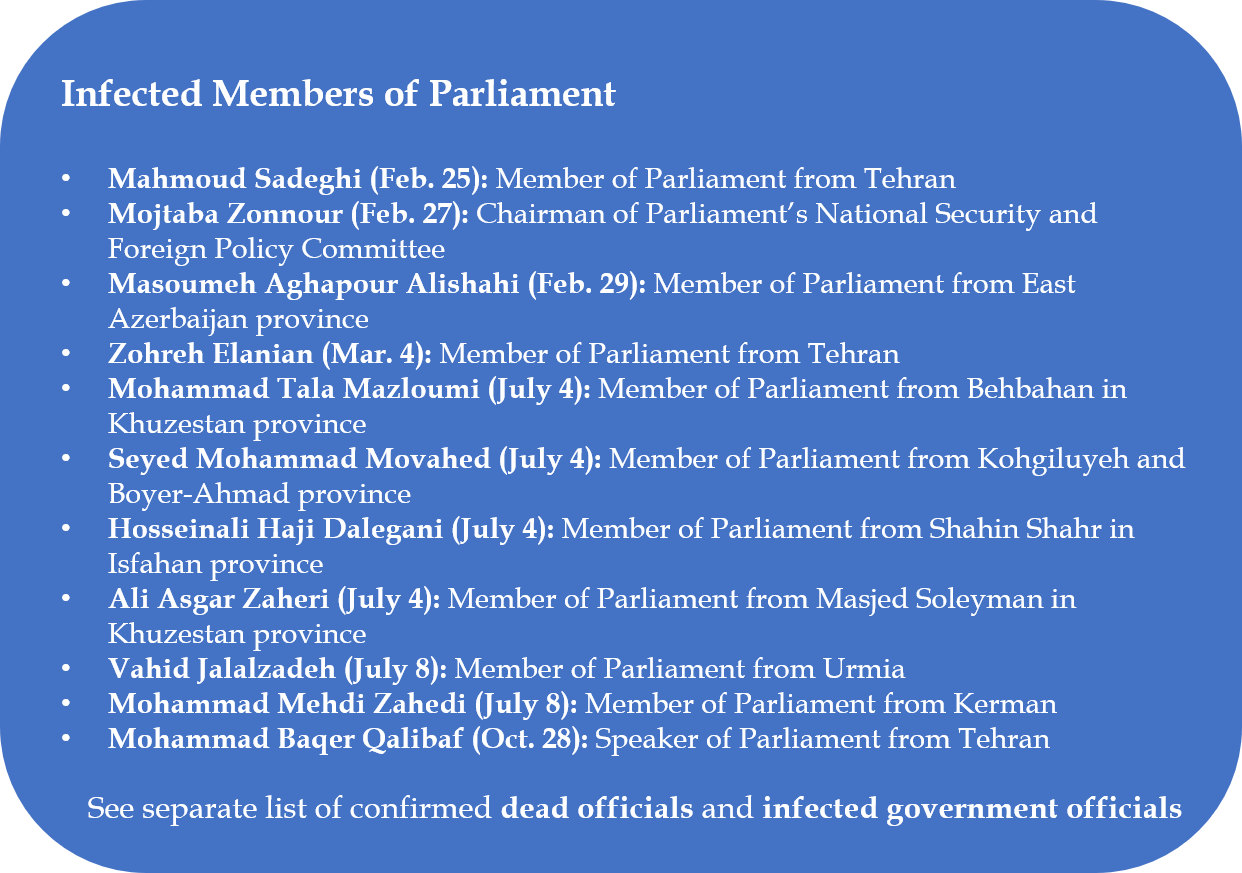
But the new measures was unable to contain the pandemic. October 19 was dubbed "Black Monday" by local media after 377 people died in a single day, a record high. More than 5,000 new COVID-19 cases were reported by the Health Ministry the next day. Record high cases and deaths were reported every week in October and November.
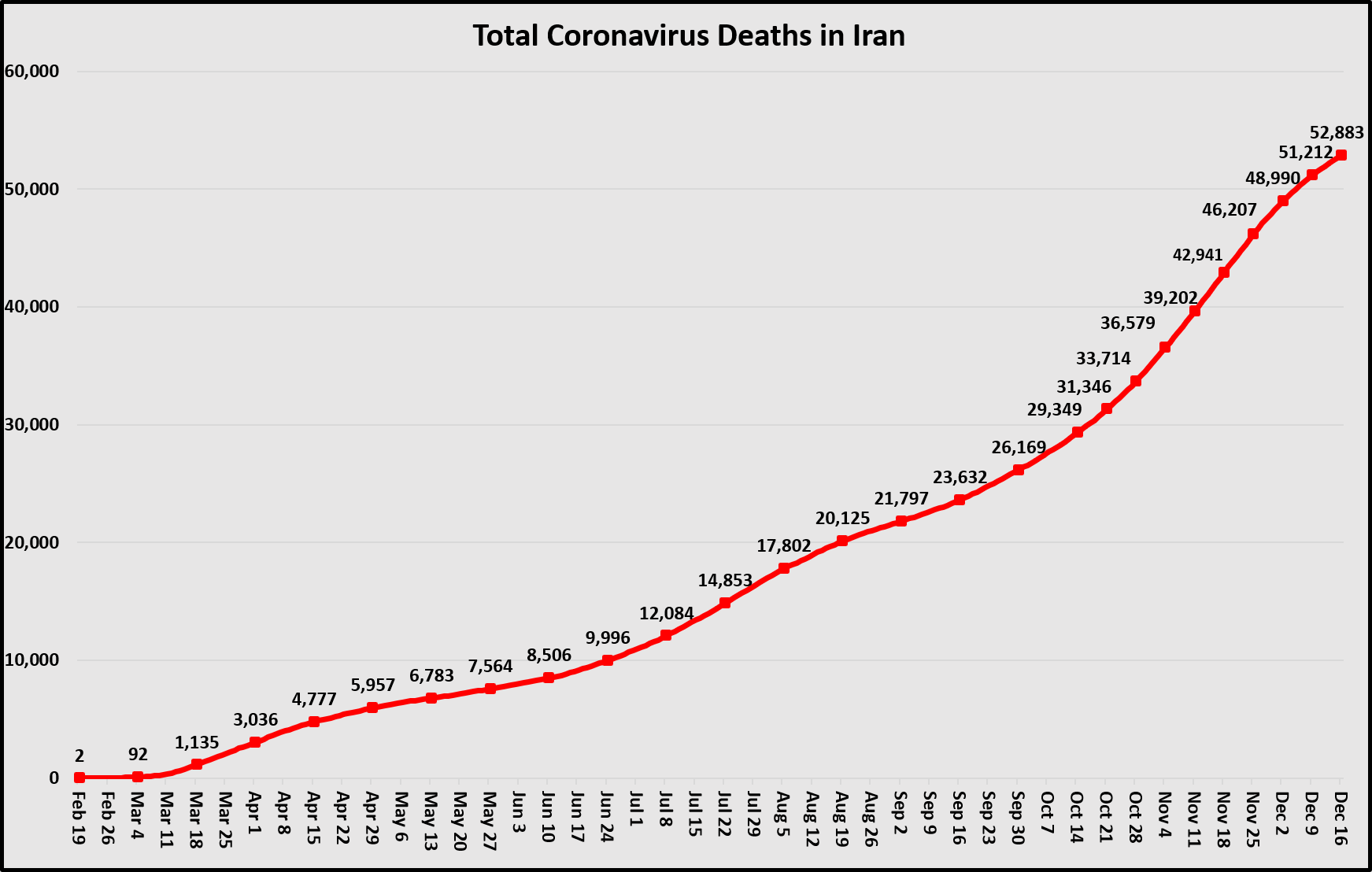
Iran has long sought relief from U.S. sanctions to deal with the pandemic. At the U.N. General Assembly in September, President Rouhani blamed the Trump administration for blocking needed medical and humanitarian supplies. “All of us across the globe are experiencing difficult times during the pandemic. However, my nation, the resilient people of Iran, instead of enjoying global partnership and cooperation, is grappling with the harshest sanctions in history imposed in blatant and gross violation of the Charter of the United Nations, international agreements and Security Council Resolution 2231," he said on September 23. To deal with the deepening growing pandemic, Tehran has sought new partnerships with India, Russia and China for the production and delivery of a coronavirus vaccine.
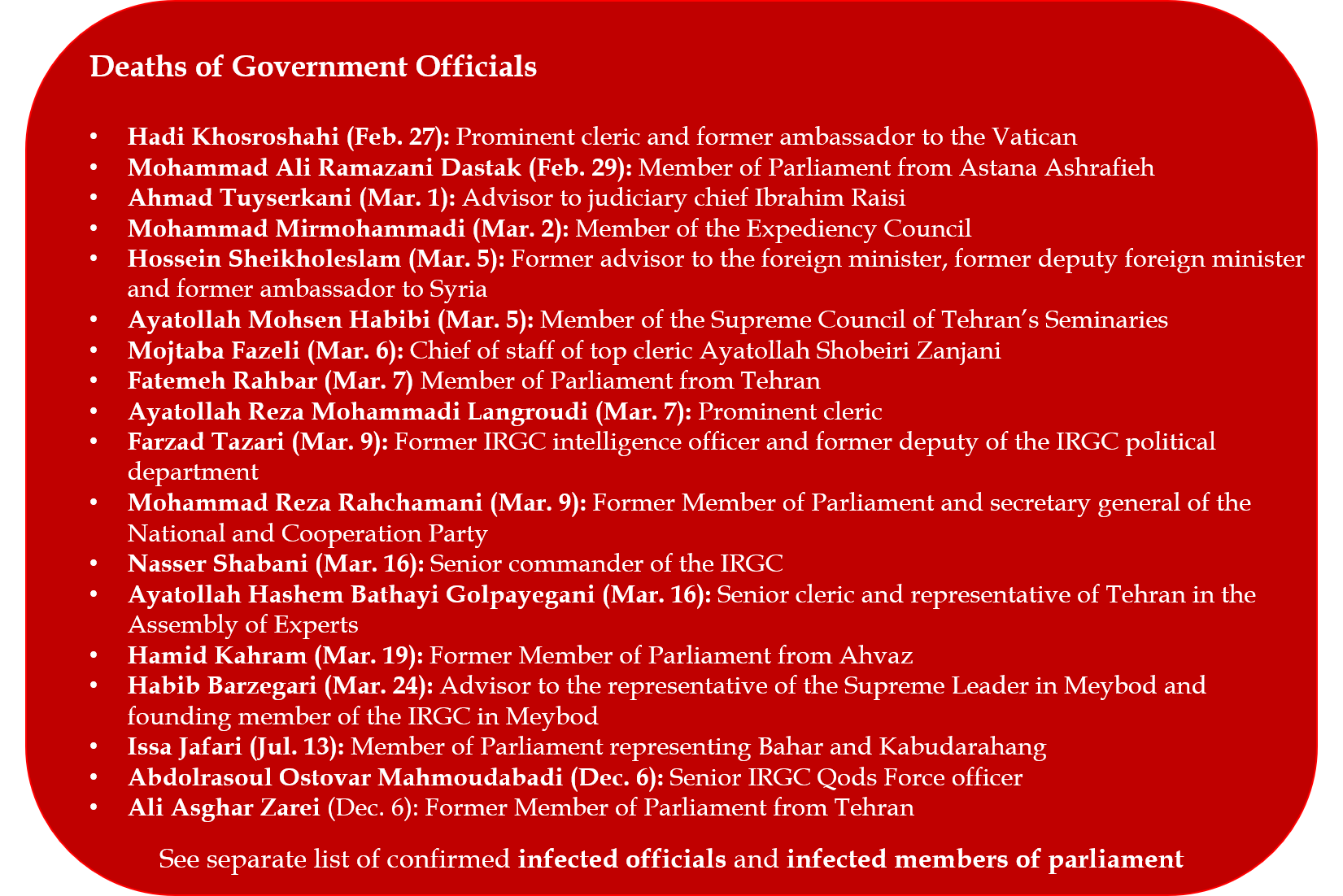
For details and analysis on the first seven months of the COVID-19 pandemic, see:
- "Part 1: Coronavirus Strikes Iran"
- “Part 2: Iran Tries to Reopen"
- “Part 3: Iran's Surge in COVID-19 Cases”
- "Iranian Officials Infected by COVID-19"
- "COVID-19 by the Numbers: U.S. versus Iran"
Week 31: September 13 – September 19
On September 14, Iran recorded the highest daily increase in COVID-19 fatalities since mid-August. More than 150 patients died in a single day; the overall official death toll stood at 23,313.
On September 17, Rouhani pledged to add 10,000 beds to hospitals across the country before March 2021. The beds would distributed to hospitals to seven provinces -- in Tehran, East Azerbaijan, Esfahan, Sistan and Baluchestan, Kurdistan, Mazandaran and Gilan.
On September 18, Iran's health ministry issued a coronavirus red alert for the entire country because of a new spike in cases. “We no longer have orange and yellow,” Deputy Health Minister Harirchi said. “The entire country is red.” Harirchi warned that the death toll could reach 45,000 if the fatality rate did not decrease.
On September 18, the Tehran Stock Exchange experienced growth for the first time in five consecutive weeks.
On September 19, Iran’s health minister said that Tehran would purchase 20 million doses of a coronavirus vaccine from an Indian company. Iran had negotiated a “lower and more reasonable price” for the vaccine, he claimed.
Week 32: September 20 – September 26
On September 20, the banking sector loaned more than $1 billion to private sector businesses impacted by the coronavirus over a six-week period, the governor of Iran’s Central Bank said.
On September 22, the health ministry reported an all-time high in new infections. More than 3,700 new cases were identified in one day, which was the highest daily increase since the pandemic was first tracked in February.
On September 22, Iran cancelled public processions for the Shiite holiday of Arbaeen. The government discouraged Iranians from traveling to the holy city of Karbala for the pilgrimage. In turn, Iraq said that no Iranian pilgrims would be allowed to cross the border.
On September 23, President Rouhani blasted the United States for maintaining sanctions on Iran during COVID-19 pandemic. “My nation, the resilient people of Iran, instead of enjoying global partnership and cooperation, is grappling with the harshest sanctions in history,” he told a virtual meeting of the U.N. General Assembly.
#COVID19 is a common pain, demonstrating that our ignorance outweighs our knowledge
— Hassan Rouhani (@HassanRouhani) September 22, 2020
It reminds us of imperative of humility &humbleness, that global issues need global participation
Iranians are grappling w/ harshest sanctions in history imposed in blatant violation of UN Charter
On September 24, the official death toll from the novel coronavirus was more than 25,000, the health ministry reported.
On September 25, Iran and Russia discussed jointly developing a COVID-19 vaccine. “Iran has great potential to produce the vaccine,” said Kazem Jalali, the Iranian ambassador to Moscow.
On September 26, Rouhani authorized provincial lockdowns to stem a surge in COVID-19 cases. Governors were empowered to implement one-week lockdowns of schools, universities, mosques, cafeterias and other public places.
Week 33: September 27 – October 3
On September 29, Iran announced that coronavirus infections exceeded 450,000. The death toll reached almost 26,000.
On September 30, Rouhani praised the establishment of a joint Iranian-Danish medical and pharmaceutical center in Tehran. International cooperation during the pandemic is a " very important," he said.
On October 1, Iran was ready to work with China on joint production of a coronavirus vaccine, Rouhani said.
On October 3, Iran closed schools, libraries and mosques in Tehran for a week to control the spread of the novel coronavirus. President Rouhani said that the government would fine those who violated health protocols.
Week 34: October 4 – October 10
On October 5, Iran reported 3,902 cases of COVID-19—a new daily record—and 235 deaths.
On October 6, Deputy Health Minister Iraj Harirchi announcedll that all Iranians would be required to wear masks in public as of October 10. The government discussed how much to fine citizens who broke heath protocols. All flights to Turkey were suspended until November 1, the civil aviation authority announced.
On October 7, the daily death toll hit an all-time high at 239, the health ministry reported.
The US regime w/
— Iran Foreign Ministry 🇮🇷 (@IRIMFA_EN) October 7, 2020
- highest num of Covid19 cases & deaths;
- a superspreader at its head;
- a record of denial of the disease;
- & continued mismanagement of its impact,
has no standing to lecture others.
As long as sanctions r in place, your hypocritical offers sound hollow. https://t.co/hiZunDAcDM
On October 9, Iran stopped admitting non-emergency patients to hospitals due to the surge in coronavirus patients, the health ministry said. All military medical units were mobilized to set up field hospitals and mobilize support for hospitals, Rear Admiral Habibollah Sayyari said.
On October 10, Face masks became mandatory in Tehran. Violators faced fines of 500,000 rials. President Rouhani allocated $100 million to purchase rapid coronavirus test kits. He spoke with Russian President Vladimir Putin on jointly developing a COVID-19 vaccine.
Week 35: October 11 – October 17
On October 12, daily deaths from COVID-19 reached a record high of 272. Vaccine trials on human subjects would begin within weeks, the health ministry said.
On October 13, Iran resumed gas exports to Iraqi Kurdistan. Iran and Mali cancelled a soccer match in Antalya, Turkey after several Malian players tested positive for the coronavirus. IRGC medical facilities and personnel were focused on fighting the coronavirus, Revolutionary Guards commander Hossein Salami said.
#Iran’s Health Ministry Spokesperson, Lari announced on Tuesday:
— IranGov.ir (@Iran_GOV) October 13, 2020
🔷Total number of #COVID19 patients recovered: 411,840
🔷Total number of infected cases: 508,389
🔷Total number of death toll: 29,070
In the past 24 hours:
🔷New cases tested positive: 4,108
🔷New death toll: 254 pic.twitter.com/ioRQocUnHY
On October 14, Iran imposed a three-day travel ban on five cities: Tehran, Karaj, Mashhad, Isfahan and Orumiyeh. The ban would run from October 17 to 19 after the daily death toll rose to 279 and broke the record for the third time in a week.
On October 16, Iran Air announced an emergency return flight home for any Iranian residing in Rome after Italy recorded more than 5,000 new cases on October 9. The flight was scheduled for October 26.
On October 17, the government extended its shutdown of Tehran for a third week. Schools, mosques, restaurant and businesses remained closed until at least October 23. Iran's conventional armed forces prepared to make all military hospitals and medical centers available to coronavirus patients.
Week 36: October 18 – October 24
On October 18, The World Health Organization delivered 150 ventilators to Iran. It also donated 100 PCR machines used for testing positive cases of COVID-19.
On October 19, Iran shattered its single day record with 337 deaths.
On October 20, Iran broke its single day record for daily COVID-19 cases, with 5,039 new infections.
On October 21, Iran broke its daily record for new COVID-19 cases for the second consecutive day, with 5,616 new infections.
#Iran’s Health Ministry Spox, Lari announced on Wednesday:
— IranGov.ir (@Iran_GOV) October 21, 2020
🔷Total number of #COVID19 patients recovered: 438,709
🔷Total number of infected cases: 545,286
🔷Total number of death toll: 31,346
In the past 24 hours:
🔷New cases tested positive: 5,616
🔷New death toll: 312 pic.twitter.com/pD1TFAySeH
On October 22, the Central Bank urged the International Monetary Fund (IMF) to grant Iran emergency loans to fight the pandemic. Iran had not asked the IMF for a loan since the 1960s.Tehran first requested a $5 billion loan in March, but the Trump administration blocked the funds.
On October 23, Iran reported 6,134 new coronavirus cases, another record high.
On October 24, Supreme Leader Khamenei recommended banning "unnecessary travel between cities" and "imposing strict regulations" on public transportation and public spaces.
Week 37: October 25 – October 31
On October 26, one person was dying every four minutes from COVID-19, state television reported. Partial lockdown measures went into effect in 43 cities. Nearly all private businesses, religious institutions and government buildings were told to remain closed until November 20. Half of all public sector employees were told to work remotely.
Corona's proven deadly, vicious & brutal everywhere, but it's worse in Iran as it has a cruel collaborator: US regime.
— Iran Foreign Ministry 🇮🇷 (@IRIMFA_EN) October 26, 2020
U.S. has elevated max pressure to Health Terrorism & targeted Iranian ppl w/ inhuman sanx while they're fighting the pandemic.
We'll overcome but NEVER forget. pic.twitter.com/n3c9QuIfQ7
On October 27, daily deaths reached a new record of 346, the Health Ministry reported. President Rouhani appointed his interior minister, Dr. Rahmani Fazli, to head a new COVID-19 operational center. The actual death toll might be three or four times the official tally, a senior member of Iran's medical professional organization said.
On October 28, the daily death toll exceeded 400 for the first time. One person was dying every three minutes from COVID-19, state television reported. Parliament Speaker Mohammad Baqer Qalibaf tested positive for the coronavirus, he announced on Twitter.

On October 29, new coronavirus daily cases reached an all-time high of 8,293.
On October 30, Iran exceeded 600,000 total confirmed coronavirus cases.
On October 31, the government indefinitely banned all weddings, wakes and conferences in Tehran. It also extended the lockdown of all public areas by one week.
Week 38: November 1 – November 7
On November 1, the head of Iran's Medical Council, Mohammadreza Zafarghandi, said that true death toll was "at least three times higher than the official death toll." The Council reached its figure through field surveys in hospitals and cemeteries.
On November 2, the government imposed a four-day travel ban on 25 cities. The daily death toll reached 440, another record high.
On November 3, new daily coronavirus cases hit 8,932, another record high.
On November 4, banks and tourism businesses hurt by the pandemic began receiving government loans.
On November 7, President Rouhani called for "strict observance" of health protocols. “Dealing with the coronavirus outbreak is an easy issue if health protocols are followed, but if members of the society ignore health protocols and become ill, it will be a difficult issue for the entire country," he said.
— IranGov.ir (@Iran_GOV) November 8, 2020
Week 39: November 8 – November 14
On November 9, Iran surpassed 10,000 new daily coronavirus cases. The government approved four herbal medicines for treating coronavirus symptoms. "None of these drugs are a cure for COVID-19, but they have effects to reduce the symptoms of this disease," said Kianoush Jahanpour, the spokesperson for Iran’s Food and Drug Administration.
On November 10, the government imposed a month-long nightly curfew starting at 6 p.m. on restaurants and nonessential businesses in Tehran and other large cities. More than 100,000 coronavirus tests would be carried out per day, the health ministry said.
#Iran’s Health Ministry Spox, Lari announced on Tuesday:
— IranGov.ir (@Iran_GOV) November 10, 2020
🔷Total number of #COVID19 patients recovered: 530,694
🔷Total number of infected cases: 703, 288
🔷Total number of death toll: 39,202
In the past 24 hours:
🔷New cases tested positive: 10,339
🔷New death toll: 453 pic.twitter.com/KJBAOoStxP
On November 11, Iran's daily death toll reached 462, another record high.
On November 13, Tehran was considering a two-week total lockdown of the capital that would include all non-essential businesses, Iranian media reported.
On November 14, the government began human clinical trials for two potential coronavirus vaccines.
Week 40: November 15 – November 21
On November 15, President Rouhani announced that Iran would impose a "comprehensive lockdown" starting on November 21. Non-essential businesses would be closed and cars would not be permitted to enter or leave 100 cities. "The government has no choice but to impose new policies and restrictions at the suggestion of experts and prevent the spread of the destructive virus," he said.
On November 16, Iran's COVID-19 outbreak broke another record high, with 13,053 new infections and 486 death in a single day.
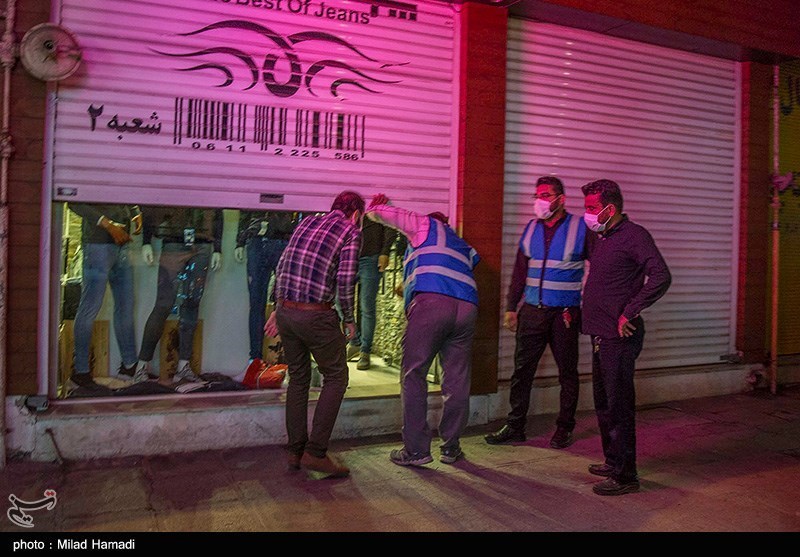
On November 17, President Rouhani pledged economic relief to businesses hurt by the lockdown measures in next year's budget, which would be submitted to parliament by December 5.
On November 18, Iran recorded another all-time high, with 13,421 new cases. More than 800,000 people had been infected since February.
On November 21, lockdowns for non-essential businesses and travel bans between major cities went into effect. Streets in Tehran remained "crowded despite the restrictions," state TV reported.
Week 41: November 22 – November 28
On November 24, the government threatened businesses that violated lockdown with fines ranging from 3 million rials ($11.50) to 15 million rials ($57.80). New cases hit another record high, with 13,721 infections within 24 hours.
On November 26, the health ministry confirmed that Iranian scientists would cooperate with Russian companies to develop a vaccine.
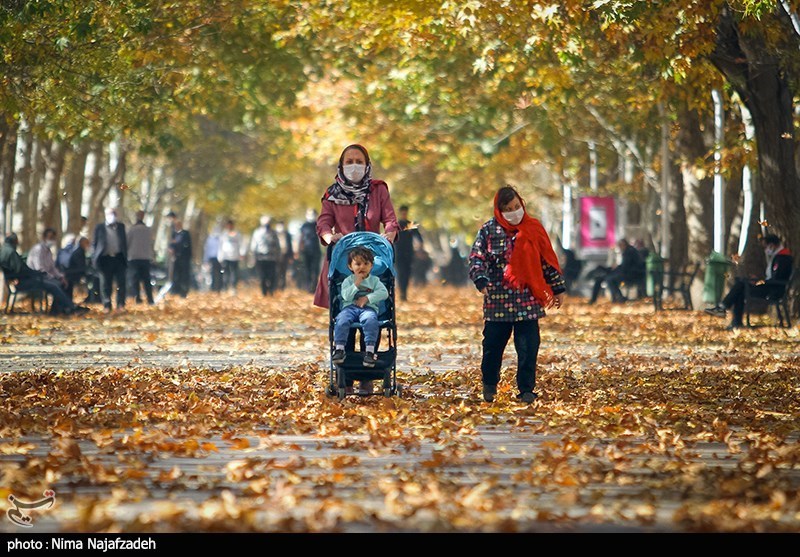
On November 27, daily coronavirus cases exceeded 14,000 for the first time, another all-time high.
Week 42: November 29 – December 5
On December 1, President Rouhani pledged to support the "underprivileged" and those hit hardest by the pandemic in 2021 budget bill.
On December 2, the government said businesses in Tehran would be permitted to reopen on December 5 after a two-week lockdown. Iran would begin domestic production of a coronavirus vaccine in the spring, Health Minister Saeed Namaki said.
On December 3, Iran's total COVID-19 cases since February exceeded one million.
On December 4, the government extended lockdowns across major cities for another two weeks.
On December 5, the government unveiled a new relief package for businesses impacted by COVID-19. The measures included tax relief and postponing bank and insurance payments.
Week 43: December 6 – December 12
On December 7, the Central Bank governor claimed that U.S. financial sanctions were blocking purchase of the coronavirus vaccine by Iran.
On December 9, the government would both import and produce domestically the COVID-19 vaccine in the coming months, President Rouhani said. He claimed that U.S. financial sanctions were blocking Iran's ability to importing medicines, vaccines and medical equipment.
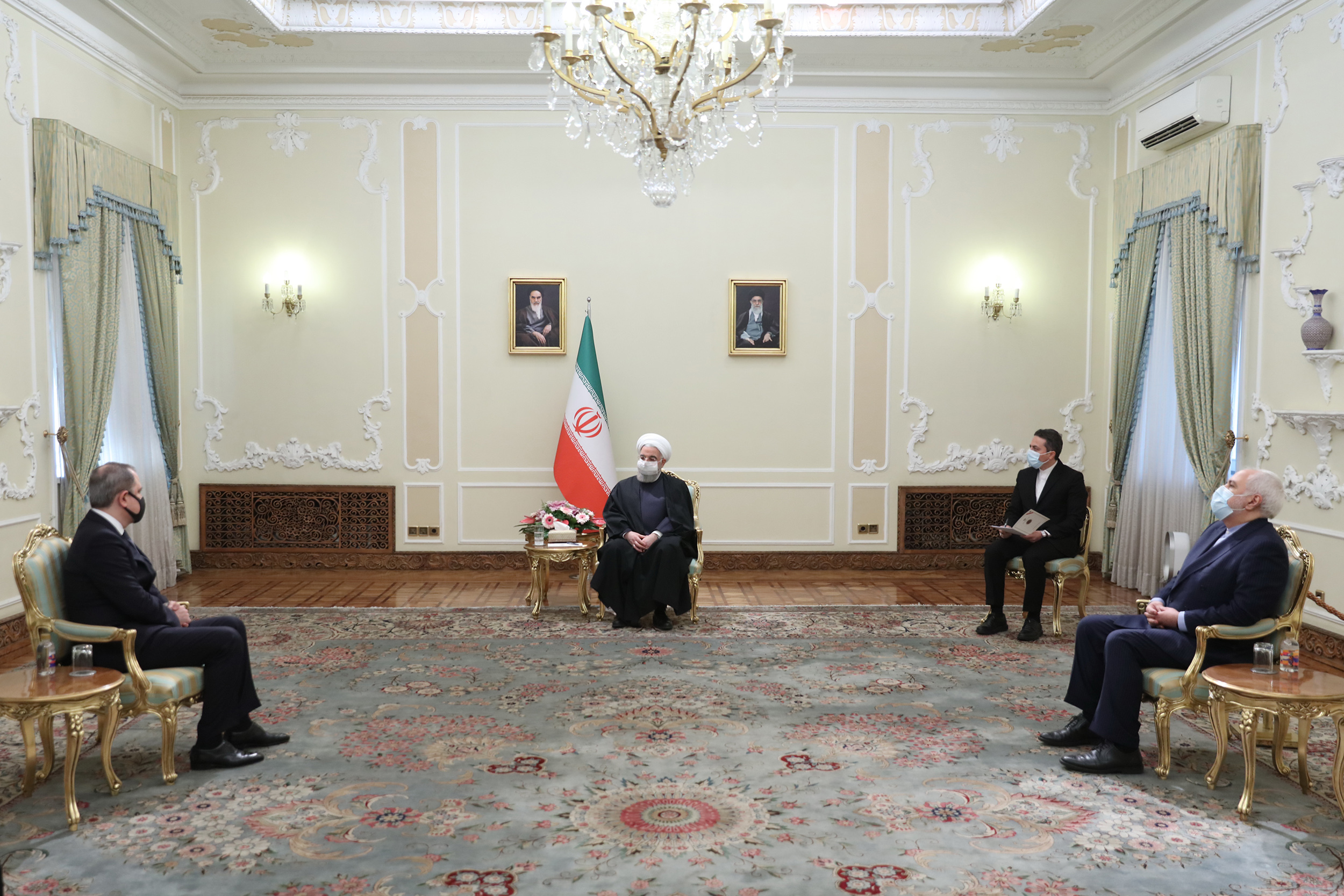
On December 12, deaths from coronavirus infections were down significantly, Health Minister Namaki said. "We will have a much brighter prospect in tackling the pandemic,” he told reporters.
Week 44: December 13 – December 19
On December 13, the number of cities on red alert dropped from 160 to 23, the health ministry said. The number of new infections dropped to the lowest since October.
On December 14, Iran would distribute its homegrown COVID-19 vaccine early next summer, the health ministry said.
On December 15, COVID-19 deaths in Tehran province had dropped significantly due to health protocols and lockdown measures, the provincial governor said. “Although we have not reached stable circumstances, the disease is being better managed compared to last month,” Governor Anoushiravan Mohseni-Bandpey said. He warned that easing restrictions prematurely could trigger a new rise in infections.
On December 16, Iran would issue permits to produce Remdesivir, an anti-viral drug effective in COVID-19 treatment, Health Minister Namaki said.
Photo credits: Temperature check via Mehr News Agency (CC By 4.0), Iran Newspaper via Iran Front Pages (CC by 4.0); Business closure via Tasnim News Agency (CC by 4.0); Fall Foliage via Tasnim News Agency (CC by 4.0); Rouhani social distancing via President.ir
Andrew Hanna, a program specialist at the U.S. Institute of Peace, assembled this report
